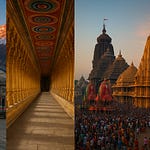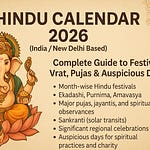🕉️ The Divine Birth of a Righteous King
Ram Navami, celebrated on the ninth day (Navami) of Chaitra Shukla Paksha, marks the incarnation of Lord Ram, the 7th avatar of Vishnu, in Treta Yuga, at noon (Madhyahana). The divine energy that descended into Kaushalya's womb in the holy city of Ayodhya is revered as the manifestation of Dharma itself. In 2025, the festival resonates with an unmatched spiritual intensity due to the recent Pran Pratishtha of Ram Lalla in the Shri Ram Janmbhoomi Mandir, a moment awaited for over 500 years.
🛕 Ayodhya – The Cradle of Lord Ram
📍Ayodhya: The Eternal City of God
Mentioned in the Rigveda, Ayodhya is one of the Sapta Puris—the seven holiest pilgrimage centers.
Located on the banks of River Sarayu, Ayodhya symbolizes cosmic harmony and divine order.
It was ruled by the Ikshvaku dynasty, believed to be descended from Surya (Sun God).
🌟 Mythical Significance
Ram’s birth was divine—Lord Vishnu took human form to end Ravana’s tyranny.
He was born under Punarvasu Nakshatra, at noon, with Jupiter in Cancer and Moon in Cancer, as per scriptures.
🙏 Ram Lalla: The Bal Roop of Bhagwan Ram
👶 The Child Form of God
Ram Lalla Virajman, literally means "Infant Ram Seated in Glory".
The current idol was consecrated in Jan 2024 inside the grand Shri Ram Janmbhoomi Mandir.
Idol is 51 inches tall, carved from Krishna Shila (dark granite), representing a 5-year-old divine child, smiling, with bow in left hand and arrow in right.
🔱 Symbolism of the Idol
Innocence and power coexist in the Bal Roop.
It reflects childlike purity, but also cosmic energy ready to destroy Adharma.
📖 Ram Navami Through the Ages: Historical & Cultural Perspective
🏛️ Ancient Observances
Celebrated since Vedic times, especially in Ayodhya, Mithila, Kashi, and South India.
Kings of the Gupta and Chola dynasties patronized Ram Navami as a royal festival.
Bhagavata Purana, Valmiki Ramayana, and Ramcharitmanas describe the glory of Ram Janmotsav.
🕊️ During Colonial India
Ram Navami became a symbol of cultural resistance during British rule.
It was celebrated by freedom fighters like Bal Gangadhar Tilak to unify Hindus.
The Ram Janmabhoomi movement reignited the relevance of Ram Navami in the late 20th century.
🎉 Celebrations & Rituals in Ayodhya
⛅ 1. Pre-Dawn Preparation
Punya Snan (Holy bath) in the Sarayu River before sunrise is considered extremely auspicious.
Devotees chant “Om Shri Ramaya Namah” while bathing.
🌄 2. Mangala Aarti at Ram Janmbhoomi
At 5:00 AM, the temple opens with Aarti, conch shells, and Vedic hymns.
Special floral arrangements and Rangoli decorations adorn the complex.
🛁 3. Abhishekam of Ram Lalla
Ritual bathing with Panchamrit, sandalwood, saffron water, honey, and rose water.
Idol is then dressed in Pitambar (yellow silk) with jewelry and a gold crown.
📿 4. Fasting (Upvaas) and Bhakti
Thousands observe Nirjala Vrat (without water) or Phalahar Vrat till Madhyahana.
Devotees chant Ram Raksha Stotra, Sundarkand, and Hanuman Chalisa.
🎭 5. Ramlila Performances
Live dramatic renditions of Ramayana from local artists and spiritual groups.
Each character is played with utmost devotion, believed to invoke the divine leelas.
🚩 6. Shobha Yatra / Rath Yatra
Decorated elephants, horses, and palanquins carry deities across Ayodhya.
Massive participation by saints, akharas, and devotees with flags, drums, and kirtans.
🪔 7. Evening Sarayu Aarti
Lakhs of diyas (oil lamps) float on Ram ki Paidi along the Sarayu River.
Aarti by priests is followed by fireworks and bhajan sandhya.
📚 Ram Navami in Scriptures
The sacred occasion of Ram Navami—the divine birth of Lord Ram—is described and celebrated across multiple revered Hindu scriptures. Each text presents a unique philosophical and spiritual interpretation of Ram’s incarnation. The three most significant scriptural sources that speak of Ram Navami are the Valmiki Ramayana, the Ramcharitmanas by Tulsidas, and the Bhagavata Purana. Together, they offer a complete picture of Lord Ram's divine purpose, his incarnation, and the impact of his birth on the universe.
📖 Valmiki Ramayana – The Adi-Kavya (Original Epic)
The Valmiki Ramayana, composed by Maharishi Valmiki, is considered the earliest and most authentic biography of Lord Ram’s life. In the Bal Kand, the section devoted to Ram’s birth and childhood, the scripture narrates how King Dasharatha of Ayodhya, though married to three queens—Kaushalya, Kaikeyi, and Sumitra—remained without an heir for many years. Deeply troubled, Dasharatha was advised by the sage Rishyashringa to perform the Putra-Kameshti Yajna, a powerful Vedic ritual conducted to beget children.
After the yajna was performed with great faith and devotion, Agni Deva (the Fire God) manifested from the sacrificial fire and handed King Dasharatha a golden vessel filled with divine kheer (sweet rice pudding), asking him to distribute it among his queens. Dasharatha followed the instructions: he gave half to Kaushalya, a quarter to Kaikeyi, and the remaining to Sumitra.
In due course of time, the divine blessings manifested into births. Kaushalya gave birth to Ram, the embodiment of virtue and dharma. Kaikeyi gave birth to Bharata, and Sumitra, having received the remaining share, gave birth to twins—Lakshmana and Shatrughna. Thus, Lord Ram’s birth was a result of sacred rituals, divine intervention, and cosmic orchestration, not an ordinary biological event. It reflected the divine will manifesting through Vedic tradition to restore righteousness on Earth.
📖 Ramcharitmanas – The Bhakti-Packed Retelling by Tulsidas
Centuries later, the great saint and poet Goswami Tulsidas composed the Ramcharitmanas in Awadhi, which is revered as one of the most devotional renditions of the Ramayana. In the Bal Kand of this text, Tulsidas captures the moment of Lord Ram’s birth with poetic beauty, divine joy, and emotional depth. He writes:
"Navami tithi madhumasa punita, Shukla paksha abhijit hariprita..."
This translates to: On the auspicious Navami tithi (ninth lunar day) of the bright half of the month of Chaitra, during the sacred Abhijit Muhurat so dear to Lord Hari, the Supreme took human form.
Tulsidas describes the cosmic alignment at the moment of Ram’s birth. The Sun was in Aries, the Moon in Cancer, and the planet Jupiter was exalted, forming an extraordinarily auspicious configuration. At that very moment, the atmosphere turned divine—winds softened, flowers bloomed spontaneously, and celestial beings rained flowers from the sky. The entire city of Ayodhya was immersed in celebration, as though heaven itself had descended on Earth.
The emphasis in Ramcharitmanas is not just on the birth itself, but on the ecstatic emotional response of nature, gods, saints, and devotees. Tulsidas paints Ram’s birth as a celebration of divine bliss and the arrival of the Supreme Being in human form to bless the world with his presence and teachings.
📖 Bhagavata Purana – A Philosophical and Theological Perspective
The Bhagavata Purana, particularly in the 9th Canto (Skanda), describes Lord Ram’s birth from the perspective of divine avatars and cosmic balance. It explains that Lord Ram is not just a great king or a righteous human—but an incarnation of Bhagwan Vishnu, who descended to Earth to protect the righteous, annihilate the wicked, and establish dharma (cosmic order).
The Purana recounts the lineage of the Suryavansha (Solar Dynasty), highlighting that Ram was born to King Dasharatha as part of a divine mission. It connects his birth with the broader cosmic plan of Vishnu, who takes avatars in every age to guide the world and restore balance.
While the Bhagavata Purana doesn’t focus heavily on the ceremonial aspects of Ram’s birth, it emphasizes its philosophical necessity. Ram, it says, came as the Maryada Purushottam—the ideal man, king, son, husband, and warrior—to show the world how to live a life grounded in values, selflessness, sacrifice, and service.
🌺 The Unified Message of the Scriptures
Through these three scriptures, we understand that Ram’s birth was not just a historical event, but a timeless cosmic occurrence. The Valmiki Ramayana grounds the event in ritual, lineage, and royal dharma. The Ramcharitmanas elevates it with devotional ecstasy and bhakti, making it a heart-centered celebration. The Bhagavata Purana, on the other hand, places it within the universal framework of Vishnu’s incarnations, reflecting the eternal battle between good and evil.
Each text adds a layer of spiritual depth to Ram Navami. Together, they inspire millions of devotees to reflect on truth, righteousness, humility, service, and the triumph of light over darkness, year after year, through the sacred remembrance of Lord Ram's birth in Ayodhya.
🌍 Ram Navami: A Festival of Global Relevance
Celebrated across Nepal, Mauritius, Indonesia, Fiji, Trinidad, South Africa, and NRIs in the USA/UK.
Major temples in the West like BAPS Swaminarayan Mandirs, ISKCON, and Ram Mandirs organize week-long Ramayana lectures and pujas.
📊 Socio-Economic Impact on Ayodhya
🚧 Infrastructure Boost
Ayodhya has seen massive growth post Ram Mandir inauguration: airports, roads, hotels, riverfronts.
Over 2 crore pilgrims visited within 2 months of temple inauguration.
🛍️ Local Economy Surge
Surge in demand for prasad, handicrafts, Hanuman flags, religious souvenirs.
Small vendors, sweet shops, temple guides, taxi services are witnessing economic revival.
💼 Jobs & Spiritual Tourism
Ayodhya aims to become India’s spiritual capital, opening lakhs of direct & indirect jobs.
Upcoming Ramayana Circuit projects boost cultural tourism.
🧘♀️ Spiritual Practices for Devotees
Mantras for the Day:
“Shri Ram Jai Ram Jai Jai Ram”
“Om Dasharathaye Vidmahe, Sita Vallabhaya Dheemahi, Tanno Ramah Prachodayat”
Donations & Seva:
Gifting clothes, books, feeding cows, planting trees in Ram’s name.
Parayan (Reading):
Entire Ramcharitmanas or Valmiki Ramayana in 9 days (Ramnavmi Navah Parayan).
Ram Navami is not just a day of external celebration—it is a time for deep inner reflection, devotion, and spiritual elevation. For countless devotees across the world, this sacred day is an opportunity to connect directly with the divine essence of Lord Ram, embody his virtues, and walk the path of Dharma. The spiritual practices observed on this day go beyond rituals and become transformative experiences of bhakti (devotion), seva (service), and sadhana (spiritual discipline).
One of the most powerful and simple practices is the chanting of sacred mantras. The most beloved and widely used mantra on this day is “Shri Ram Jai Ram Jai Jai Ram”. This mantra, popularized by saints like Neem Karoli Baba and Ramdas Swami, is considered to be infused with the vibrational essence of Ram’s presence. Chanting it repeatedly with focus and love creates a calming, protective, and spiritually purifying energy around the devotee.
Another potent Vedic mantra is the Ram Gayatri Mantra:
“Om Dasharathaye Vidmahe, Sita Vallabhaya Dheemahi, Tanno Ramah Prachodayat”.
This mantra means, “We meditate upon Dasharatha’s son, the beloved of Sita. May Lord Ram inspire and illumine our intellect.” This mantra aligns the mind and heart with the divine qualities of Shri Ram—valor, compassion, righteousness, and wisdom.
Beyond chanting, devotees engage in acts of seva (selfless service) as offerings of love and gratitude to Lord Ram. It is a common practice to donate clothes to the needy, distribute spiritual books, feed cows (which are sacred and deeply connected to Ram’s legacy), and plant trees as a symbol of nurturing life—each act performed with the intention of pleasing Lord Ram and following his footsteps of care and responsibility towards all beings.
Another revered practice during the Ram Navami period is the Ramnavmi Navah Parayan, which involves reading the entire Ramcharitmanas by Goswami Tulsidas or the Valmiki Ramayana over a period of nine days, beginning from the first day of Chaitra Navratri and concluding on Ram Navami. This is considered an extremely auspicious sadhana. It immerses the devotee into the divine leelas (pastimes) of Ram, helping them absorb his teachings, his character, and his spiritual message at a profound level.
Many spiritual seekers also observe a vrat (fast) on Ram Navami, refraining from food or following a fruit and milk-based diet, dedicating the entire day to prayer, silence, and meditation. The fast is often broken only after performing the Ram Janmotsav puja at noon, the time Lord Ram is believed to have taken birth.
These practices, though varied in form, share a common purpose: to invoke the living presence of Ram within the heart of the devotee. On this day, devotees do not just remember the Lord as a figure from history—they experience Him as a living force guiding their thoughts, actions, and intentions. The true celebration of Ram Navami lies not in external festivity alone, but in this inner awakening to the ideals of Shri Ram—truth, courage, humility, sacrifice, and unconditional love.
📸 Visual Grandeur of 2025 Celebrations (Expected Highlights)
Drone light shows of Ramayana scenes across Sarayu Ghats.
Live global telecast of Ram Navami from Shri Ram Janmbhoomi Mandir.
AI-powered virtual Ram Darshan for global devotees.
Mega Akhand Bhajan Mahotsav with 108 musical groups.
✨ A Living Legacy of Love, Truth & Dharma
Ram Navami is not just about celebration—it’s a spiritual rebirth of values. In Ayodhya, the divine vibrations on this day cleanse karma, awaken the inner Rama, and rejuvenate the soul. The essence of Maryada Purushottam Ram lives through every chant, every diya, every act of seva.
As crores bow before Ram Lalla Virajman, we are reminded:
“Ram is not just a King, Ram is a Way of Life.”










